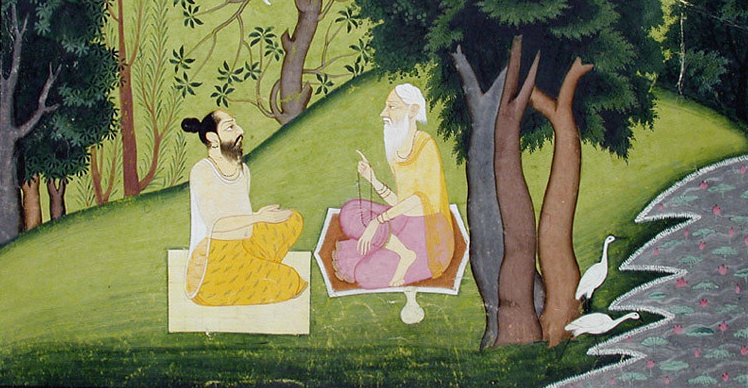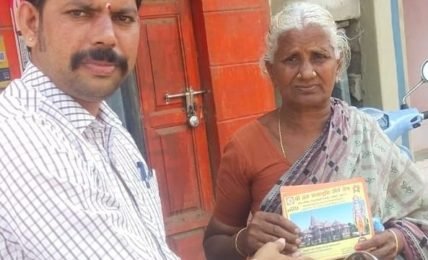Shwetaketu, Do you know who you are?


Narrator: Here is a conversation between a father Sage Uddalaka Aruni (उद्दालक अरुणी) and his son Shwetaketu (श्वेतकेतू). This dialogue appears in the Chhandogya Upanishad (छांदोग्य उपनिषद) of the Samaveda (सामवेद). It is a part of the Brahman Book (ब्राह्मण ग्रंथ) called Chhandogya Brahman (छांदोग्य ब्राह्मण). Like other Upanishads, Chhandogya too was compiled long before the time of Gautam Buddha. Behold! The students are singing this Upanishada’s Shanti Mantra (शांतीमंत्र) –
Chorus
ॐ सह नाववतु ।
सह नौ भुनक्तु ।
सह वीर्यं करवावहै ।
तेजस्वि नावधीतमस्तु मा विद्विषावहै।
ॐ शान्तिः शान्तिः शान्तिः ॥
Om, May we all be protected!
May we all be well nourished!
May we all work together with great energy!
May our study be glorious!
Let there be no enimity between us!
Om! Let there be peace (in me), peace (in nature) and peace (in universe)!
Shwetaketu: At the age of 12, I was sent to the hermitage to learn the Veda and the Vedanga. In 12 years, I mastered the 4 Vedas and the sciences of phonetics, etymology, grammar and astronomy as well. I also completed the studies of the Shastras. And by the way, may I also mention, that I was the brightest student at the hermitage.
Narrator: Shwetaketu knew he was a genius. Equipped with this strong belief he soon became proud and arrogant. The father was worried by his behavior and decided to do something about it. He summoned Shwetaketu.
Aruni: Shwetaketu, my learned boy, did you learn from your Guru about the ultimate knowledge, by which everything becomes known?
Shwetaketu: No Father! I don’t think my Guru knew about such a thing. Otherwise he would have taught me.
Aruni: Dear Son, did you ask him for this knowledge?
Shwetaketu: Does such a knowledge exist?
Aruni: Yes, indeed.
Shwetaketu: I must admit that I never asked my Guru to teach me about it. Please do tell me about this knowledge by which everything else becomes known.
Aruni: Shwetaketu, it is knowledge of the Brahma! The ultimate truth! It is from the Brahma that this whole world came into being. Thus by knowing it, everything else comes to be known.
Shwetaketu: How can the world that is made up of so many different things, come from one Brahma?
Aruni: Son, see this pot, a pan and a toy cart? They are different products. But they are all made out of clay. Or see the ornaments of your mother. The earrings, the bangles and the necklace. Though they are different, they are all made of gold. Or take a look at this nail cutter made of iron. If you understand the properties of iron, you will understand the properties of the nail cutter and everything else that is made of iron. Similarly If you understand the properties of clay you will understand the properties of all the pots, pans and clay toy carts.
Shwetaketu: Father, this is something that I did not learn at the hermitage. Please tell me more about the Brahma.
Aruni: In the beginning, there was only Sat (सत्)! From which – various forms of energy like heat, light etc were created. Then Water was created. Then Food was created. From the Food three forms of life – Andaj (अंडज), Jaraj (जारज), and Udbhij (उद्भीज) were created. Andaj are the life forms born from egg. Jaraj are the life form born from womb that is the mammals and Udbhij are life forms born from the Earth like the plants. The Brahma lives in all these life forms as Jeev or Atma (जीव / आत्मा).
Just as the pots and pans of clay have different Naam-Rupa (names and forms); the Brahma appears as various life forms with different names and forms. When the Naam-Rupa is lost, the essence of the pots and pans; that is the clay is revealed. Similarly when one looks beyond the names and forms of objects, the Brahma is revealed.
Shwetaketu: Father, I do not understand how from one micro being (सूक्ष्म) Brahma the entire world is created. Please explain to me this again.
Aruni: Well then! Go, bring me one fruit of that Banyan tree.
Shwetaketu: Here it is father.
Aruni: What do you see in it?
Shwetaketu: I see very tiny seeds in it.
Aruni: Well then break open one seed. What do you see?
Shwetaketu: I see nothing at all inside it.
Aruni: Can a huge banyan tree come out of nothing? Of course not! It is just that you are not able to see the subtle essence in the seed from which this banyan tree came into being. The Bramha is that subtle essence in every being. It is the Brahma that resides in everything as Atma.
Chorus:
स य एषो S णीमै तदात्म्यम् इदं सर्वं
तत् सत्यं स आत्मा तत्त्वमसि श्वेतकेतो
इति भूय एव मा भगवान् विज्ञापयत्वीति
तथा सोम्येति होवाच || छां. ६.१२.३ ||
That which I have described so far
That which is smaller than an atom
That which is the reason of every being
That is the Atma, Shwetaketu!
You too are that Atma!
तत्त्वमसि! तत्त्वमसि!! तत्त्वमसि!!!
Shwetaketu: How is it that this Atma is present everywhere, but it cannot be seen?
Aruni: Bring me a glass of water and few crystals of salt.
Shwetaketu: Here it is.
Aruni: Put those crystals in the glass of water.
Shwetaketu: Yes Father!
Aruni: Now tell the taste the water from the left edge of the glass.
Shwetaketu: It is salty, Sir!
Aruni: Now tell the taste the water from the right edge of the glass.
Shwetaketu: It is salty, Sir!
Aruni: Now tell the taste the water that is at the bottom of the glass.
Shwetaketu: This too is salty to taste, Sir!
Aruni: The salt is present everywhere but it cannot be seen. To find it, one has to examine the water, one has to taste it. Similarly to realize the Atma that resides in everything one has to carry out an examination.
Chorus:
स य एषो S णीमै तदात्म्यम् इदं सर्वं
तत् सत्यं स आत्मा तत्त्वमसि श्वेतकेतो
इति भूय एव मा भगवान् विज्ञापयत्वीति
तथा सोम्येति होवाच || छां. ६.१३.३ ||
That which I have described so far
That which is smaller than an atom
That which resides everywhere
That is the Atma, Shwetaketu!
You too are that Atma!
तत्त्वमसि! तत्त्वमसि!! तत्त्वमसि!!!
Aruni: The Brahma is beyond all names and forms. No form or name can describe it. Hence while describing the Brahma, the Vedas say “न इति, न इति”, its neither likes, nor like that! Just as by knowing clay, the material cause, all kinds of pots and pans can be understood. By knowing the Brahma, all of is forms can be known. The Brahma is the cause of everything that is.
Chorus:
|| ब्रह्म सत्यं, जगत् मिथ्या ||
The Brahma is the ultimate truth.
The Jagat that is created from it is an illusion.
Aruni: Dear child, all the rivers flow into the ocean and become a part of it. The rivers lose their names and forms once they have emptied into the ocean. Similarly, once a being merges with the Brahma, they lose their name and form, to become the Brahma. Then there is no coming back. Shwetaketu, know that the name and form are not permanent, but the Atma is permanent. The Atma is immortal. And that immortal being is you Shwetaketu!
Chorus:
तत्त्वमसि श्वेतकेतो
तत्त्वमसि! तत्त्वमसि!! तत्त्वमसि!!!
Shwetaketu: Father, now I understand. Every Being comes from the Brahma. Every being acquires a name and a form. And after giving up name and form every being merges into Brahma. But, how does one find the Bramha?
Aruni: Son, Say a person is left in an unknown place, far away from his home. What will he do? He will inquire about how to reach his city. Right? He will then follow the instructions of the people who have travelled to his hometown to reach home. Similarly a person can know how to reach the Brahma from a Guru. A Brahmanishtha and Shrotriya Guru will guide you Shwetaketu.
Narrator: Thus the father described the ultimate truth, and as a by product the son learnt humility too! Like all the Upanishadas, this one too is in the form of dialogue. Question and Answer. Student asks a question, and the Guru gives an answer or directs the student to find the answer. It reminds one of the Socratic method of learning. Like Krishna says in Bhagvat Geeta – परिप्रश्नेन सेवया, ask me questions to fulfill your thirst of knowledge. Let’s end this retelling, by reciting the Shantipath. Let us all say it together!
Chorus:
ॐ सह नाववतु ।
सह नौ भुनक्तु ।
सह वीर्यं करवावहै ।
तेजस्वि नावधीतमस्तु मा विद्विषावहै।
ॐ शान्तिः शान्तिः शान्तिः ॥
Based on the Marathi translation of Chhandogya Upanishad – S. K. Deodhar, Prasad Prakashan.
DISCLAIMER: The author is solely responsible for the views expressed in this article. The author carries the responsibility for citing and/or licensing of images utilized within the text.

